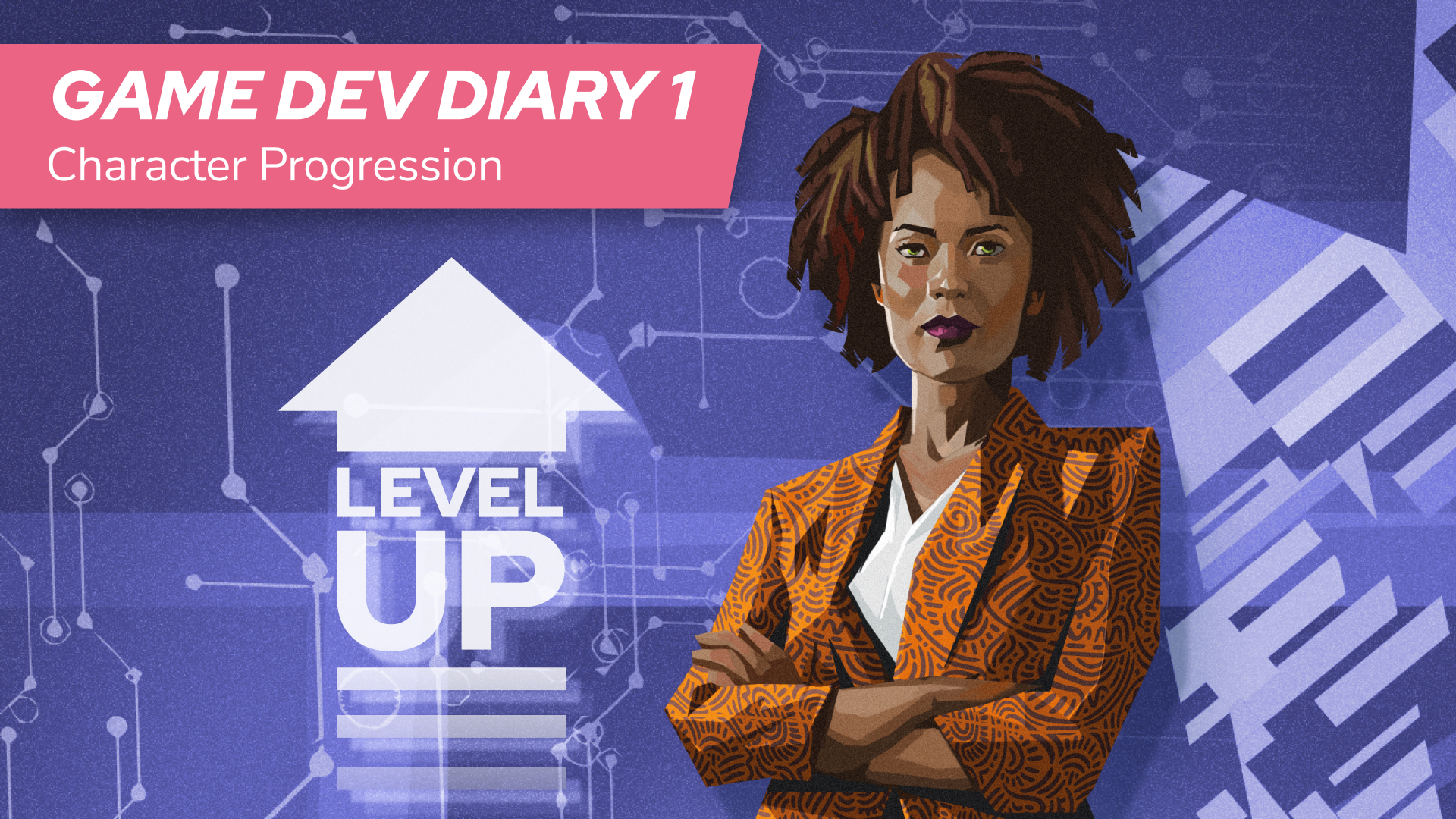Hey everyone!
I’m Francesco, Lead Game Designer at Hopeful Games. And I’m here to showcase NEON HOPE’s progression system.

Why is the Progression System so Important?
NEON HOPE is a campaign-based game where you play one character over the course of multiple episodes. Advancing your character during the campaign is not only something players expect, but is also a large part of the fun for many of them. For example, it can feel very rewarding when you easily defeat an Elite Enemy later in the campaign that gave you a lot of trouble in the first episode.
In NEON HOPE, the progression system is also especially important, because it is where almost all of the character customization takes place. One of our core design goals is to offer a great experience to players who do not want to construct a deck. You should be able to pick a character, immediately start playing and have a great time. However, we believe these players still enjoy tinkering with their characters, they just do not want to sit down to theorize a character build before the campaign begins. Therefore, we moved almost all customization to within episodes. Only a singular choice must be taken before the first game: Which of my two Character Tools am I using?
(There are advanced rules to construct a deck for those players who love to theorize character builds. But it is not required even for the harder difficulties.)
To summarize, we had two core requirements for our progression system:
- Progression must feel significant.
- Progression must allow you to choose which aspects your character should grow.
Level Ups and Resources
How is this realized? After each episode each character…
- levels up 2 Action cards
- earns 2 additional starting Resources
The “A Better Humanity” campaign consists of 5 episodes, meaning in the final episode each character will have earned 8 level-ups, and 8 starting Resources.
Each character comes with 8 Action cards and each Action card has a LVL 1, LVL 2, and LVL 3 version. Meaning in the last episode your deck could consist of eight LVL 2 cards, or four LVL 3 and four LVL 1 cards, or everything in between. It turned out to be a great number – high enough to make you feel a lot stronger than at the beginning, yet leaving enough room to focus on certain aspects of your character.
Resources are spent to purchase Tools, at the beginning or during the course of an episode. Each character has 8 Tools in their Tool kit. With 8 starting Resources you could buy 2-3 Tools right at the beginning of the final episode and purchase 2-3 more while playing. That again proved to be a good balance between fulfilling a power fantasy and providing customization needs.
Action Card Level Up Versions
Let us look at some level up paths for Felina’s Action cards.
(The current illustrations are placeholder art, but we will show sketches for Felina’s cards soon in an upcoming Dev Diary from my co-founder Torben.)
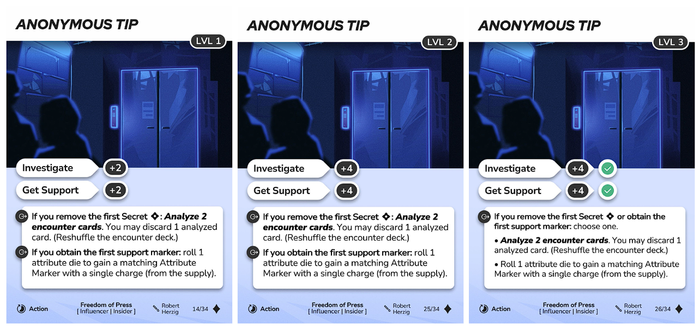
I want to show you Anonymous Tip’s progression path first. Because it is simple yet effective: You get an additional +2 attribute boost for your first level up, and an additional Impact for your second level up. As a cherry on the top, you get extra flexibility on the LVL 3 version. This serves as a benchmark on what kind of increase in power level you can expect from leveling up an Action card.
Of course, the power of a card can come in different flavors:
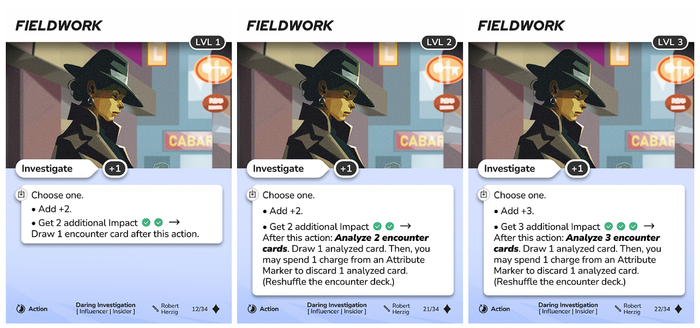
Let’s consider Fieldwork: looking at the jump from the LVL 1 to the LVL 2 version, here the raw numbers do not change at all. Instead, the effect is improved. The LVL 1 version of Fieldwork is already very powerful, allowing you to investigate with 3 total impact, but comes with a hefty drawback: you need to draw an encounter card. The LVL 2 version softens the drawback a lot by giving you the choice between 2 cards and can turn it even into an advantage by allowing you discard the nastier encounter card. The LVL 3 version builds on this and offers even more additional Impact.

As my final example, I want to tell you how Stay Undercover was developed. Here, we actually came up with the LVL 3 version first: A card that allows Felina to approach Enemies differently. As the character with the lowest Courage and only one other Fight card, we wanted Felina to have at least one card which handles Enemies. Stay Undercover lets you shuffle an Enemy back into the encounter deck if you have double their retreat value. That works very well with Felina, as she has a variety of ways to discard cards from the encounter deck. A smart player can try to discard the Enemy before it appears again.
However, the complexity of this effect was a bit too much for a LVL 1 card. (And maybe even too powerful as well?) Therefore, we came up with simpler LVL 1 and LVL 2 versions of the card, and restricted the shuffle-back-effect to the LVL 3 version. This has the added benefit that it feels even more rewarding to invest into leveling up the card to gain this powerful effect, compared to if we had given it to you right from the start.
Extra Tools
With the additional starting Resources earned throughout the campaign you can buy extra Tools right from the start of an episode.
To get an impression of what you can expect from a Tool, let us consider two Insider-Tools:

Insatiable Curiosity gives you one additional Investigate action on each of your turns. It is what we call a Value Tool. The extra action is good regardless of which of Felina’s strengths you decided to focus on. It might not be the best buy in all game situations, but it is always solid.
Reliable Source on the other hand has an effect that is only triggered when you discard a card from the encounter deck, usually by effects that let you analyze the encounter deck. We call that a Synergy Tool. These Tools have effects that synergize with your Character Tool or with some of your Action cards.
By offering you both kinds of Tools you have the choice to heavily specialize in an aspect of your character or stay flexible by leaning more into Value Tools. The cool thing is: Your choice can change from episode to episode! You get more starting Resources after each episode, but you do not have to use them to buy the same Tools you bought before. Experimenting with your build or adapting to the requirements of the episode are both encouraged.
What the Progression System is not
One thing we avoid in NEON HOPE’s progression system are dictated choices.
Characters come with 2 different Character Tools. This usually means they have 2 gameplay styles they can specialize in. In Felina’s case they are:
- Get many Attribute Markers and use them for powerful effects.
- Analyze the encounter deck and discard the biggest threats.
The level up versions of your Action cards should work well with both Character Tools. If the LVL 2 or LVL 3 card would only go along with one Character Tool, your choice of leveling up cards would be dictated by the choice of your Character Tool. Fieldwork for example let’s you analyze the encounter deck, which works great with the Cybernetic Retina, but also goes great with the extra Atribute Markers from Insider Source: because you are performing a task with up to 4 potential Impact you want to boost your chance of success with as many Attribute Markers as you can.
As a small reward for everyone who made it this far, I want to show you all of Felina’s Action cards and Tools. Here you go:
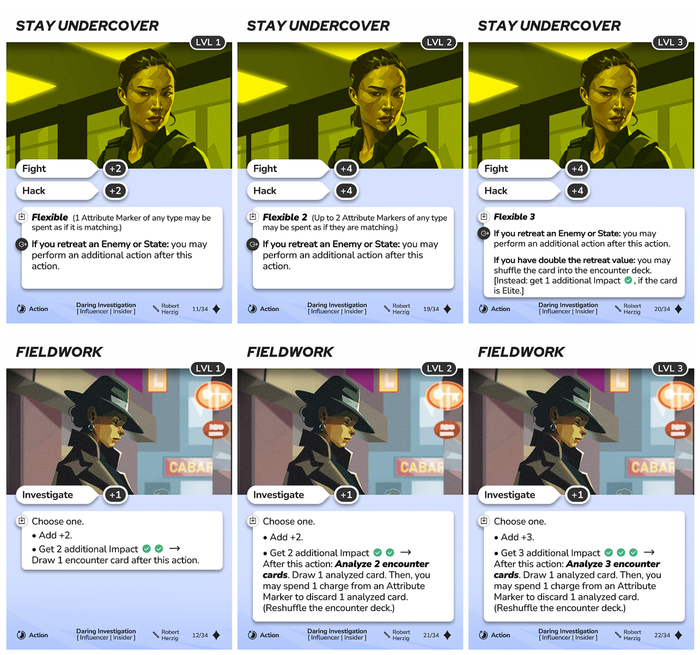

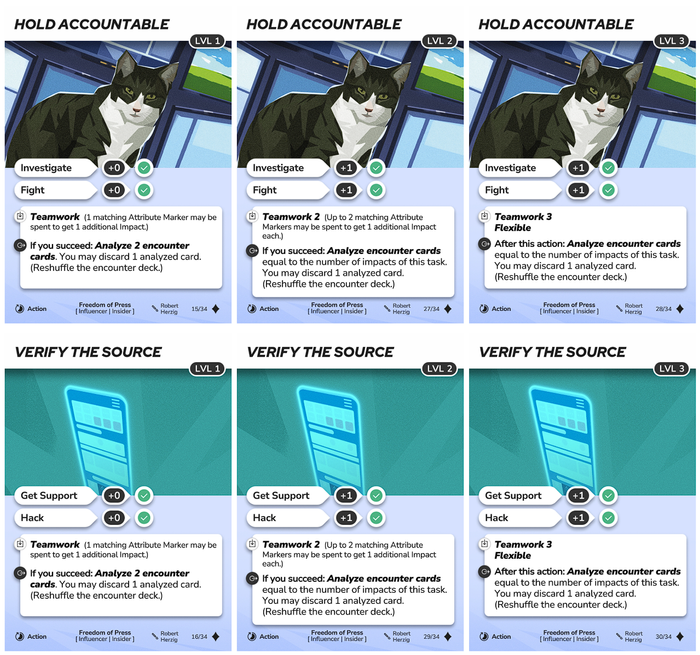

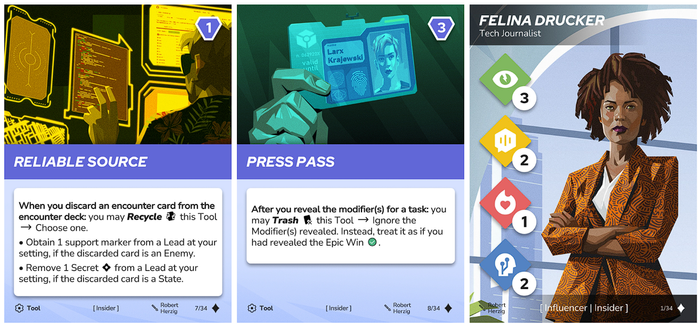
And this is it for the progression system! We are excited to see how you engage with this system, what campaign builds will be developed for each character, and how you enjoy it. We believe the flexibility of this system will provide a lot of opportunities for you to experiment in meaningful ways. Enabling you to progress through the campaign in a way that you enjoy.
Please let us know in the comments, what topics you would like us to discuss for the next Dev Diary! Or which Character Tool of Felina you think has the most potential for an interesting build.
Until then, may you never run out of Hope or Resources!
Yours,
Francesco

